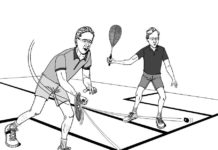An “Official” Q&A
by Barry Faguy
HEY REF Is it true that the PSA decided to eliminate the usual practice of giving only a let (instead of an obvious stroke) when the striker refrains from hitting the non-striker with the ball—specifically in those cases where the ball has first hit the back wall?
Yes, it’s true. We’ve touched on this before, but the recent PSA decision renews the discussion.
THE CONVENTION
Squash has a few conventions, meaning ways of proceeding that don’t exactly follow the rules, but which referees and players pretty much accept. This particular one can be called the danger-zone convention, referring to the triangle formed by the ball and the two front corners. The rules state that if the non-striker is standing in that zone at the moment the striker can hit the ball to the front wall, then a stroke against the non-striker is required. And it isn’t supposed to matter how the ball reached the striker: it could have come directly from the front wall, or it could have come after hitting the back wall (usually after first hitting a side wall). But the convention is such that if it’s the latter—then only a let is given. And oddly enough, that let only applies if the striker refrains; if the striker actually hits the non-striker with the ball—then the striker is awarded the stroke.
This convention has trickled down to the amateur levels in varying degrees, but enough that many people believe that the let is what the rules mandate. In any case, it sure looks like the PSA has just reached its limit of tolerance (and possibly embarrassment at how blatant this can sometimes be); only time will tell if the change sticks. We should see referees sticking to the letter of the law and awarding the stroke; we should also see wider clearing by players to vacate that danger zone when the return comes off the back wall. Those changes should be noticeable, because in over half of these situations (whether play stops or not) a stroke is possible because the better players can easily bring the ball in enough to hit the opponent.
So, if you’re looking for advice for when it’s your turn to ref, the safest best is to stick with the rules—an approach now made easier with the PSA is on board. If you had the habit of abiding by that convention, this is your chance to get back on track. Here are some topical guidelines that might help:
Yes let: Remember that lets weren’t always given because of the convention. Sometimes it might have been justified because the ball was on a low, dying trajectory as it came off the walls and a boast was likely the only return possible. The let also could have been due to uncertainty about any of the many factors at play, such as whether the opponent was clearly in the zone or whether the striker was actually able to bring the ball inward enough to hit the opponent.
No let: Sometimes this decision was perfectly justified because the ball was simply too close to the back wall and any return was precluded. This was a determination that, of course, would vary significantly with player level. Alternatively, a let could be denied if the non-striker was well clear, meaning there was neither interference nor fear of injury.
Stroke: Sometimes the gods of squash had things lined up such that the opponent was clearly in the danger zone and would have been hit; only a stroke is appropriate. Remember that for this kind of interference, the non-striker’s clearing effort doesn’t matter, because the non-striker is either in that zone or not. And the last potential justification for a stroke occurs when the ball bounces forward enough off the back wall such that we’re no longer talking about ball interference; now we’re usually talking major swing interference.




